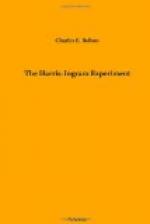Though England has neither gold nor silver mines, yet for centuries she has commanded vast capital. Her trading enterprise, which has made the Englishman conspicuous round the world, existed long before the Norman conquest. Helpful and consistent legislation has also favored British industries. Besides, England enjoyed a good start in the race with foreigners. Surplus English capital of late has been employed in promoting foreign industry, and the interests of England as a rival may suffer.
Reaching the station at Denmark Hill, the colonel and George drove at once to Bessemer’s home. It is doubtful if England has forty acres, owned by a private citizen, more tastefully laid out and adorned, with forests, lawns, and flowers.
Henry Bessemer was tall and well formed, and looked the ideal Englishman, as he gave cordial welcome, in his large drawing room, to Colonel Harris and George Ingram. Evidences of his constructive skill and exquisite taste were seen on every hand, notably in his billiard room, conservatory, and astronomical observatory. The last contained a reflector telescope of his own design, that rivals the world-famed telescope of Lord Rosse. Both were soon charmed with Bessemer’s manners and conversation.
George had read of this wonderful man who was born in 1813; between 1838 and 1875 he had taken out 113 patents, and the drawings of his own work made seven thick volumes. This record of Bessemer indicates an almost unrivalled degree of mental activity and versatility as keen observer, original thinker, and clever inventor.
His drawings showed patents in connection with improvements in engines, cars, wheels, axles, tires, brakes, and rails. Fifteen patents for improvements in sugar manufacture, patents for motors and hydraulic apparatus, for the manufacture of iron and steel, the shaping, embossing, shearing, and cutting of metals, for marine artillery, ordnance, projectiles, ammunition, armor plates, screw propellers, anchors, silvering glass, casting of type, patents for bronze powder, gold paint, oils, varnishes, asphalt pavements, waterproof fabrics, lenses, etc.
Mr. Bessemer’s greatest invention, announced to the British Association at Cheltenham, in 1856, is his method of the manufacture of iron and steel without fuel, which started a new era in the iron trade. His name will be forever associated with the rapid conversion of pig iron into malleable iron and steel. By this process the price of steel per ton has been reduced from $160 to $25, a price less than was formerly paid for iron. Mr. Bessemer received the Telford and Albert gold medals and honors from sovereigns and societies round the world.
George said to Mr. Bessemer that he thought Lord Palmerston’s definition, “dirt was matter out of place,” was especially applicable to the undesirable elements in ores.
“Very true,” replied Mr. Bessemer, “and the man who can clean the dirt from our ores, and produce the most desirable steel, at the least cost, is a great benefactor of humanity.”




